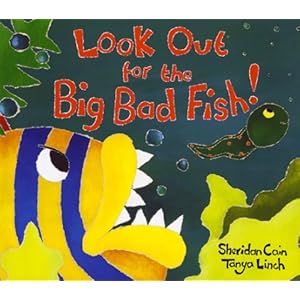
Watch Out for the Big Bad Fish! by Sheridan Cain and illustrated by Tanya Linch is a fun story about a young tadpole who wants to jump so badly. As he grows he meets many different animals who are able to jump, teaching him to wait patiently for he will be able to jump one day. Finally the young tadpole grows into a frog, just in time to jump out of the mouth of the Big Bad Fish.
The bright, colorful, torn-paper collages of this book capture children's attention and the repeated "Boing!" onomatopoeia is fun for children. This book is a fun way to teach the life cycle of a frog and the upbeat story has a moral that all children can relate to, having to wait patiently to grow-up.
Curriculum Connections
Not only is Look Out for the Big Bad Fish! a fun book to read, it also ties in well with the life science SOLs. The book illustrates the changes that the tadpole goes through before he becomes a frog and is able to jump (2.4a). The book also, even though not explicitly, acknowledges that living things are interdependent, the tadpole needs his mother to survive and the Big Bad Fish wants to eat the frog (2.5a).
Additional Resources
- DLTK provides printable templates for an activity where students can cut and paste the life cycle of a frog. Larger templates are also given so teachers may use them on bulletin boards.
- Kidszone is a website that offers students many different ways to learn and test thier knowledge of the life cycle of a frog. There are fun riddles that they can solve, worksheets both with and without word descriptions, and a creative writing topic.
- Enchanted Learning offers a worksheet with the stages of a frogs life at the top and blank lines below for students to write out each stage of the frogs life.
General Information
- Book: Look Out for the Big Bad Fish
- Author: Sheridan Cain
- Illustrator: Tanya Linch
- Publisher: Little tiger Press
- Publication Date: 1998
- Pages: 32
- Grade range: K- 3rd
- ISBN: 1888444274
